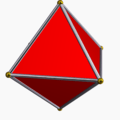Surface-area-to-volume ratio

The surface-area-to-volume ratio, also called the surface-to-volume ratio and variously denoted sa/vol or SA:V, is the amount of surface area per unit volume of an object or collection of objects. In chemical reactions involving a solid material, the surface area to volume ratio is an important factor for the reactivity, that is, the rate at which the chemical reaction will proceed.
For a given volume, the object with the smallest surface area (and therefore with the smallest SA:V) is the sphere, a consequence of the isoperimetric inequality in 3 dimensions. By contrast, objects with tiny spikes will have very large surface area for a given volume. If a cell is too large, not enough materials will be able to cross the membrane fast enough to accommodate the high cellular volume.
Dimension
The surface-area-to-volume ratio has physical dimension L−1 (inverse length) and is therefore expressed in units of inverse distance. As an example, a cube with sides of length 1 cm will have a surface area of 6 cm2 and a volume of 1 cm3. The surface to volume ratio for this cube is thus
- .
For a given shape, SA:V is inversely proportional to size. A cube 2 cm on a side has a ratio of 3 cm−1, half that of a cube 1 cm on a side. Conversely, preserving SA:V as size increases requires changing to a less compact shape.
Physical chemistry
Materials with high surface area to volume ratio (e.g. very small diameter, very porous, or otherwise not compact) react at much faster rates than monolithic materials, because more surface is available to react. Examples include grain dust; while grain isn't typically flammable, grain dust is explosive. Finely ground salt dissolves much more quickly than coarse salt.
High surface area to volume ratio provides a strong "driving force" to speed up thermodynamic processes that minimize free energy.
Biology
The ratio between the surface area and volume of cells and organisms has an enormous impact on their biology (the physiology, behavior, and other qualities of a particular organism or class of organisms). For example, many aquatic microorganisms have increased surface area to increase their drag in the water. This reduces their rate of sink and allows them to remain near the surface with less energy expenditure.
An increased surface area to volume ratio also means increased exposure to the environment. The many tentacles of jellyfish and anemones are the result of increased surface area for the acquisition of food. Greater surface area allows more of the surrounding water to be sifted for food.
Individual organs in animals are often based on the principle of greater surface area. The lung is an organ with numerous internal branchings that increase the surface area through which oxygen is passed into the blood and carbon dioxide is released from the blood. The intestine has a finely wrinkled internal surface, increasing the area through which nutrients are absorbed by the body. This is done to increase the surface area in which diffusion of oxygen and carbon dioxide in the lungs and diffusion of nutrients in villi of the small intestine can occur.
Cells can achieve a high surface area to volume ratio by being long and thin (nerve cells) or convoluted (microvilli)
Increased surface area can also lead to biological problems. More contact with the environment through the surface of a cell or an organ (relative to its volume) increases loss of water and dissolved substances. High surface area to volume ratios also present problems of temperature control in unfavorable environments.
The surface to volume ratios of organisms of different sizes also leads to some observations in biogeography such as Bergmann's rule.
Fire spread
In the context of wildfires, the ratio of the surface area of a solid fuel to its volume is an important measurement. Fire spread behavior is frequently correlated to the surface-area-to-volume ratio of the fuel (e.g. leaves and branches). The higher its value, the faster a particle responds to changes in environmental conditions, such as temperature or moisture. Higher values are also correlated to shorter fuel ignition times, and hence faster fire spread rates.
Mathematical examples
| Shape | Characteristic Length | Surface Area | Volume | SA/V ratio | SA/V ratio for unit volume | |
|---|---|---|---|---|---|---|
| Tetrahedron |  |
side | 7.21 | |||
| Cube |  |
side | 6 | |||
| Octahedron |  |
side | 5.72 | |||
| Dodecahedron |  |
side | 5.31 | |||
| Icosahedron |  |
side | 5.148 | |||
| Sphere |  |
radius | 4.836 | |||
| Capsule |  |
radius |
| side of cube | side2 | Area of side | 6*side2 | Area of Cube's Surface | side3 | Volume | Ratio of Surface Area to Volume |
|---|---|---|---|---|---|---|---|
| 2 | 2x2 | 4 | 6x2x2 | 24 | 2x2x2 | 8 | 3:1 |
| 4 | 4x4 | 16 | 6x4x4 | 96 | 4x4x4 | 64 | 3:2 |
| 6 | 6x6 | 36 | 6x6x6 | 216 | 6x6x6 | 216 | 3:3 |
| 8 | 8x8 | 64 | 6x8x8 | 384 | 8x8x8 | 512 | 3:4 |
| 12 | 12x12 | 144 | 6x12x12 | 864 | 12x12x12 | 1728 | 3:6 |
| 20 | 20x20 | 400 | 6x20x20 | 2400 | 20x20x20 | 8000 | 3:10 |
See also
References
- Schmidt-Nielsen, Knut (1984). Scaling: Why is Animal Size so Important?. New York, NY: Cambridge University Press. ISBN 978-0-521-26657-4. OCLC 10697247.
- Vogel, Steven (1988). Life's Devices: The Physical World of Animals and Plants. Princeton, NJ: Princeton University Press. ISBN 978-0-691-08504-3. OCLC 18070616.
External links
- Sizes of Organisms: The Surface Area:Volume Ratio
- National Wildfire Coordinating Group: Surface Area to Volume Ratio
- Previous link not working, references are in this document, PDF